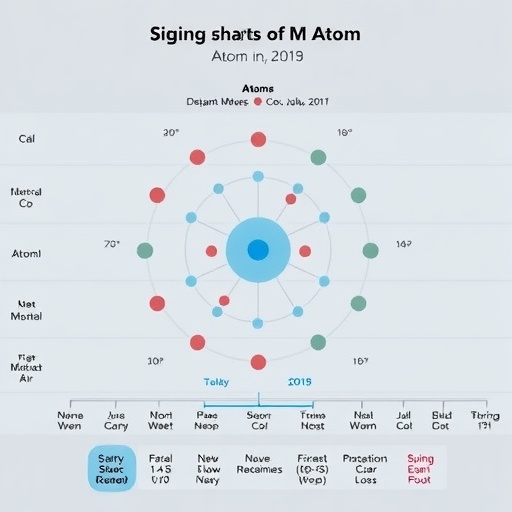Recent advancements in microscopy have revolutionized our understanding of the atomic world. Traditionally, the ability to visualize individual atoms has been hindered by the limitations of optical microscopy, which struggles to resolve features smaller than half the wavelength of light, corresponding to approximately 200-300 nanometers. However, researchers at the Massachusetts Institute of Technology (MIT) have developed a groundbreaking computational technique named ‘Discrete Grid Imaging Technique’ (DIGIT) that allows for the unprecedented resolution of individual atoms within crystal structures.
This innovative approach leverages existing knowledge of atomic configurations, enabling scientists to precisely pinpoint the locations of atoms within a material. The underlying principle is akin to having a detailed seating chart in a concert hall: while previous imaging methods could tell us which section contained an atom, DIGIT allows us to determine the exact seat — or location — of that atom. By applying this technique, the research team has achieved a remarkable resolution of 0.178 angstroms, which is significantly smaller than the width of a single atom and even exceeds measures typically associated with electron microscopy.
To better appreciate the significance of this advancement, it’s essential to grasp the challenges that have long plagued scientists in their quest to visualize atomic structures. Optical microscopes, though more user-friendly and cost-effective than their electron-based counterparts, have historically been limited in their resolution due to the diffraction of light. The Nobel Prize-winning developments in super-resolution microscopy marked a significant step forward, allowing researchers to visualize structures down to the scale of individual molecules. However, individual atoms remained elusive until DIGIT emerged.
The DIGIT technique utilizes statistical analysis alongside knowledge of a material’s atomic layout. By treating the atomic arrangement as a reference map, researchers can compute the most probable positions of atoms, even when their initial images appear as indistinct blurs. This method is especially beneficial when applied to crystalline materials where the arrangement of atoms follows strict geometrical patterns.
Digital imaging in microscopy is not merely about honing resolution; it profoundly impacts various fields. One notable application is the design of quantum devices which demand precise atom placement within materials to manipulate quantum properties effectively. Beyond quantum technologies, advancements like DIGIT can deepen our understanding of material behaviors, particularly regarding defects and impurities, which significantly influence the functionalities of semiconductors and superconductors.
Duan and her colleagues focused their investigations on diamond, a crystal well-known for its ordered atomic structure. By substituting certain carbon atoms in diamond lattices with silicon atoms, the team aimed to track and precisely locate these silicon substitutions. Using lasers tuned to frequencies resonant with silicon atoms, they gathered super-resolution images that initially appeared as uniform blurs, signifying the presence of silicon. However, DIGIT’s application transformed these indistinct images into clear determinations of atomic positions.
The scientific journey led by Duan illustrates a pivotal advancement in optical imaging. Long plagued by the stark contrast in atomic sizes compared to wavelengths of visible light, scientists are now equipped with techniques that bridge this gap. The innovative combination of existing microscopy methods with advanced computational algorithms promises to change the landscape of materials science and biology. It opens up new research avenues where finer atomic details can be probed.
Researchers are encouraged to explore the DIGIT code, which is now openly accessible via platforms like GitHub. This availability allows scientists worldwide to apply this technique to optical measurements of materials with well-known atomic structures, potentially leading to groundbreaking discoveries in both fundamental research and practical technological advancements.
While exploring the intricate world at the atomic scale, the intellectual merger of microscopy with computational techniques proves to be a transformative force. The development of DIGIT underscores the importance of interdisciplinary collaboration in tackling complex scientific challenges. The balance of theoretical knowledge, statistical modeling, and hands-on experimental techniques encapsulates the essence of modern scientific inquiry.
The ramifications of this optical imaging advancement extend well beyond the immediate application of visualizing atoms. It heralds a new era of understanding at the atomic level, fundamentally advancing the way scientists approach problems in material science and biology. With the ability to see and identify individual atoms, researchers can better unravel the complexities of atomic interactions within various materials, enabling the design of novel materials and the enhancement of existing technologies.
Through these pioneering efforts, we are witnessing a pivotal shift in how we can study and manipulate materials — a leap that could dramatically enhance innovations in quantum computing, nanotechnology, and beyond. The essence of discovery is encapsulated in the relentless pursuit of knowledge, and in this case, the prospect of visualizing the unseen world of atoms opens infinite doors of possibility.
In conclusion, the advent of DIGIT signifies a remarkable stride in optical microscopy, allowing the scientific community to navigate the previously inaccessible realm of individual atoms. As this technique matures, it promises to provide insights into complex phenomena, driving forward the frontiers of science and technology. The future holds exciting prospects as researchers adapt and apply this revolutionary imaging technique across various fields, ultimately leading to a deeper understanding of the materials that constitute the world around us.
Subject of Research: Visualization of individual atoms using optical microscopy
Article Title: “A Bayesian approach towards atomically-precise localization in fluorescence microscopy”
News Publication Date: Pending
Web References: Link
References: Not available
Image Credits: Not available




